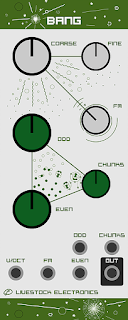 |
| Daniel from LiveStock Electronics showing me their range of modules |
and/or Belgium.
Last Saturday i had the chance to talk with Daniel Mulder, one of the co-founders of LiveStock Electronics at a special Amsterdam Dance Event SoundLab showcase event.
Livestock Electornics was founded in early 2016 and is about to release their fist modules at the end of this year. Their modules are heavily inspired by the chiptune and DIY-scene, and Daniel showed off a few interesting sounding new modules... you can find all info on their website.
 |
| LiveStock Shepard |
This module is great for polyphonic and polyrhythmic sequences. And has a lot more to offer than just triggering notes and gates!
The interface is divided into two modes, play and edit mode. In play mode loops of several channels can be selected at the same time, and easily duplicated. While edit mode gives you the possibility to create dynamic sequences for each channel. Gatescan be delayed or held, notes can be pitched, and sequences can be of different lengths, speeds and directions. Each step can also send two control voltages with a optional glide while triggered, this gives you the option to control other modules during a sequence.
The memory has room for 8 tracks with each 16 loops of 64 steps for each of the 4 channels. The loops and tracks can be selected during play mode, or controlled through cv input.
Note: This module is moddable with the Arduino IDE and modding manual (available after release).
LoveStock also supports users in modifying their modules...
 |
| LiveStock Bang |
LiveStock Electronics Bang Demo video by Paul Tas: www.youtube.com/watch?v=ZlIF1jsUHz0
 |
| LiveStock Maze |
 |
| Felix |
Use this module to copy CV’s, Gates or Audio and change the amplitude or intensitywith the attenuators.
 |
| MIR and MIR Expander |
MIR comes along with an expansion module, which gives you the option to change the amount of cv input and whether the VCA responds linear or exponentionally. Place the expansion board anywhere you like, you can also set the parameters on the pcband leave the expansion board out if you need to save some hp.
 |
| LiveStock Kepler |
KEPLER is a unique low-pass filter with four poles that are individually
controllable with knobs and cv.
The sound can range from soft and clean sounding sweeps to highly resonating self-oscillating sweeps. The cutoff is even controllable with v/oct which means that you could use the filter as an oscillator.
The LiveStock Electronics crew will tour some more through the Netherlands in the next few weeks with these new modules, so try to check them out at:
28/10 @ Bizarre Sound Creatures (Dutch Design Week) Eindhoven
02/11 @ Nerds on Stage Rotterdam
The Bang and Felix will probably be released in December or January. As for the other modules, the release depends on the next batch of prototype pcbs. If it goes as planned, you can expect them from January to August 2017!
Website: www.LiveStockElectronics.com
Facebook: www.facebook.com/LiveStockElectronics
GearSlutz demo video from ADE : https://youtu.be/9nYzxFV0CqE



















